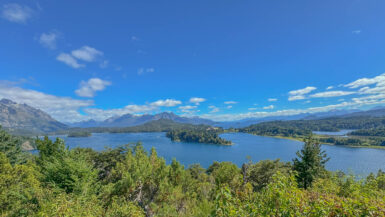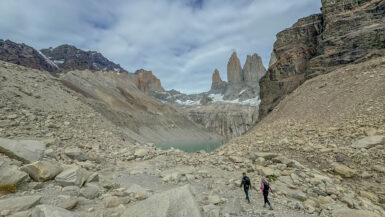Iquitos, Peru was definitely a major change of scene compared to the relatively clean, laid-back streets of Puerto Ayora, Santa Cruz in the Galapagos. What follows are some of the memorable experiences that my son and I had in Iquitos, in case you’re planning to visit this gateway to the Amazon.
Table of Contents
The long journey from Galapagos to Iquitos, Peru
Getting to Iquitos, Peru from Santa Cruz Island, Galapagos was a 24-hour journey, despite the relatively short distance. It began at our AirBnb in Puerto Ayora, Santa Cruz at 5:45am on Tuesday, March 21st (2023) with the sound of my phone alarm. Morning came sooner than I’d hoped due to a heavy downpour and thunderstorm that woke me up several times that night. After a quick shower and packing everything up, my son and I hopped in our pre-arranged taxi at 6:30am to head to the airport. Well, I should say “the canal” , rather than “airport”, as it’s not possible to take a vehicle all the way to the airport on Baltra Island. If you’re scratching your head confused, see my post on Santa Cruz for more about how all of that works.
We ended up being the first gringos to arrive at the canal. Airport workers were already getting on the ferry to Baltra. We attempted to board the boat but they asked us to wait. So we waited for the second ferry and paid our requisite $1 for 3-5 minute journey to Baltra Island. Once on Baltra, it was time to purchase the $5 per person bus ticket from the canal to the airport. I stood in front of the ticket window, but the ticket person said she wasn’t ready yet. About 10 minutes later, she was able to print out our ticket and we got on the next bus.
During the drive, we saw several land iguanas, which I was happy about because I missed them when my son pointed them out during our bus drive in the other direction upon our arrival. Those were my first land iguana sightings of the trip.
We arrived at the airport just ten minutes before the “mandatory two hours” prior to our flight, thanks to the email reminders that LATAM airlines sent us. But no other passengers were there. We were literally the first passengers to arrive in the terminal. Apparently, the two-hour window isn’t really mandatory. We went through airport security and were the only people in the food court, other than the employees behind the counter. We ended up ordering pizza from a coffee place. I was surprised they cooked it for us given that it wasn’t even 9am. It was somewhat relaxing to the be only ones at the airport. We ate our food and looked out at the landscape through screens that were inundated with moths. That moment of solitude soon ended as other passengers started to arrive and fill up the place. Finally, it was time to board our flight and say goodbye to the Galapagos Islands.

Our flight from Baltra, Galapagos to Guayaquil, Ecuador went smoothly. During the flight, we were served a relatively unusual snack, by American standards: chocolate-covered pomegranate seeds. They were pretty tasty. We arrived In Guayaquil airport and faced the harsh reality of a 7-hour 34-minute layover. However, I’d already planned a good option for us. Granted it’s a bit of a luxury, but I’d booked at a room at the Holiday Inn that is within walking distance of the airport. It turned out to be a great call. As a bonus, we were rewarded with a glimpse of a green iguana making its way into the bushes as we walked from the airport to the hotel.

We tried to check in at the Holiday Inn when we arrived at 1:45pm, but they said our room wasn’t available yet. I explained that we were there on a 7.5 hour layover and didn’t care what room they gave us. We just wanted to eat, workout at their gym, use their outdoor pool, and get showers before our next flight. That’s when she explained that we wouldn’t be able to access the gym or pool until our room key was issued. Darn! I hadn’t anticipated that. But she said she would try to get a room ready for us soon. To kill some time, we had a leisurely lunch at the hotel restaurant, happy that we weren’t in the airport.

Finally, at 3pm, we were issued a room key. We immediately changed into our workout clothes and went to the gym. It turned out to be a nice gym with an outdoor pool and hot tub, and we were the only ones there. Just the way we like it. There were nice views from the gym, and I enjoyed seeing two kiskadees (birds) take turns swooping down to the pool water to get a drink while we worked out.


After the workout, we were ready to relax in the hot tub, but it turned out that the pool was warmer than the hot tub, so that’s where we ended up instead.

After a nice workout and a soak in the pool, we went back to the room to get showers. Since we had a long night ahead of us, we decided to get one more meal before leaving for the airport. We went back to the hotel restaurant but didn’t feel hungry enough for another full meal, so we opted for a dessert. We had crepes with berries and ice cream, along with some fresh juice. It hit the spot.

Now it was time to catch a hotel shuttle back to the airport and go through security and passport control before catching our 8:30pm flight to Lima, Peru. We arrived in Lima at 10:45pm. Time for another long layover, as our next flight departed Lima at 4:25am. Ouch!
I’d booked a room at the Costa del Sol Wyndham airport hotel in Lima, but that turned out to be a waste of money. The hotel wasn’t nearly as nice as the airport hotel in Guayaquil, yet it was twice as expensive ($230!). We checked in, redeemed vouchers we received from the front desk for two free drinks at the bar (we choose water bottles), and climbed into our beds around 11:30pm. 2.5 short hours later, it was time to drag ourselves out of bed and make our way back to the airport to catch our 4:25am flight. Despite the early hour, Lima airport was busy with lots of people attempting to sleep in chairs or on the floor during their overnight layovers. In hindsight, that’s what we should have done too, even though it was a stale scene at the airport.
We finally arrived in Iquitos, Peru at 6:15am, catching the sunrise from our plane, as well as our first glimpses of the mighty Amazon river and surrounding jungle.
The motorcycle taxis of Iquitos, Peru
As soon as we arrived through airport security, we were approached by several taxi drivers offering to take us wherever we wanted to go. Seeing no other option, I followed the guidance of my AirBnb host and said to the first taxi driver that approached us that I would pay 30 Sol if he would take us to our AirBnb. He agreed and we stepped outside, dodging a few aggressive motorcycle drivers as we crossed the street.
When I think of a taxi, I typically think of a 4-door vehicle. When our driver paused in front of a motorcycle and loaded our bags on the back luggage rack, my son and I shared a laugh and we climbed in. The standard taxi in Iquitos is a motorcycle with two covered seats behind the bike. It was a fun experience.


The streets were busy, despite the early hour, with many kids getting transported to school in their uniforms. The vibe of Iquitos was very different from our previous stops. Iquitos is a gritty town, with the smell of pollution in the air and many scenes of poverty. After a 20-30 minute ride, we were deposited on the doorstep of our AirBnb at 6:50am. I handed over 50 sol to the driver and he indicated that he didn’t have any change. That was the second time that I’d been burned on that taxi driver maneuver on this trip. I should have broke the larger bills that I received from the ATM before getting a taxi. But once I did the math, I realized that 50 sol was equal to roughly $14, which seemed very reasonable to me.
Our AirBnb was a large colonial home in a good location near the water. It definitely felt old, but it was comfortable and each of the bedrooms had air conditioning, which was important given the hot weather of Iquitos. There was no air conditioning in the living room, just large screen windows.


The kaleidoscope of sights, sounds, and smells of the Jungle Market of Belén
You’d think that we would immediately take a nap at this point, since we’d been traveling for a long time. We definitely wanted to, but I’d booked a private tour of the Belén Market that started at 9am. I’d heard the Belén Market was worth seeing and this 9am tour was our only opportunity. So we had to suck it up and stay awake.
Rather than sleep, we each took a shower, which felt good. We then put on well-worn travel clothes with deep, zippered pockets, and walked down the street to Fitzcarraldo Restaurant for breakfast. It was 8:30am when we arrived at the restaurant, which gave us 30 minutes to eat before our guide would meet us there. We ordered two pizzas (again) as we had no idea what the food situation would be like for the rest of the day and figured that would keep us going for most of the day. Our guide, Lito, showed up 20 minutes early and sat down with us. I gave him two slices of my pizza. He ate one himself and put the second slice in a napkin for the boat captain. We paid the bill and walked down the street to where his boat was docked, ready for an adventure.
During our walk, Lito was already telling us about possible trip add-ons. One of them actually sounded very intriguing. He said there was a “monkey rescue” place where we could feed and hold animals. My son (a snake afficionado) asked if they had snakes. Lito said they may have an anaconda. My son then asked if people can hold the anaconda, and our guide said “yes”. After picking up our jaws off the floor, we told our guide that we definitely want to do that after Belén Market, although we were a bit skeptical about the anaconda-holding thing. Even if it was just feeding monkeys, it would still be worth it.
But first things first, it was time to board the boat and visit the Belén Market.


About 20 minutes later, we were entering Belén. According to Lito, who has lived in Belén all his life, the area we were visiting is home to around 12,000 people, although the larger area is estimated to have over 60,000 people. Canoes are the primary mode of transportation. Many of the residents originally lived in the forest, but came here to look for work or get a formal education. There is a lower and upper Belén, and I’ll share some information about each below.
Lower Belén
Lower Belén is definitely an eye-opener. Lower Belén is subject to floods due to the rise and fall of the river. As a result, the homes and other buildings are constructed above balsa rafts, making it a floating city for half of the year during the flood season. In the dry season, the water recedes and families can use the first floor of their homes and walk the streets once again.
Poverty is rampant, there’s no running water or sanitation, and many homes lack electric power. Outhouses are located directly on the water, so you can imagine how filthy the water is. I made sure to keep my mouth shut as we motored along in our boat, worried that an errant splash of water would get in my mouth or eyes and wreak havoc on my body. Despite the filthy water, we could see local people cleaning their clothes and bathing in the water. I’ve heard Belén described by others as a floating slum. It was the first time my son has ever seen that level of poverty, which is one of the reasons why I wanted to take him here. Plus, it’s always a good reminder for me to see just how lucky I am.








Upper Belén
Upper Belén is where the market and main warehouses are located. The Belén market is a jungle market, meaning that people bring all kinds of meat, fruit, and vegetables from the jungle, as well as medicinal herbs, bark, roots, and amulets made from animal parts. It’s a crazy place, with all kinds of sights, sounds and smells. Some of the smells are interesting, while others are repulsive, particularly near the water which serves as an open sewer. Similarly, some of the sights can be upsetting given the variety of wild animal meat and animals parts sold here. **WARNING: I’ve included some graphic photos below to give you an idea of what you might expect to see. Please skip to the next section if you think that some of the wild animal meat photos will haunt or upset you.


















Let’s just say you won’t be bored if you visit Belén market. My son and I were definitely glad we made the trip. It was an amazing experience, as well as a good education and reminder for both of us.
Amazing animal encounters at a wildlife rescue center near Iquitos
As we left Belén and made our way back past Iquitos on our way to visit a wildlife rescue center, we entered the main body of the Amazon river and could immediately see the water quality change for the better. We also spotted a gray dolphin as we crossed to the other bank of the river. Finally, we arrived at Serpentario Rio Amazonas Centro de Rescate De Bricela. At first glance, this wildlife rescue center didn’t look like much.



What happened next, was somewhat mind-blowing. After paying the entry fee and purchasing fruit to give to the monkeys (we were told), we were suddenly immersed in rapid-fire, amazing animal encounters, one after the other. This is what we encountered in what I’m guessing was only 15 – 20 minutes.


After getting mugged by spider monkeys, it was time to meet a blue and gold macaw. There were also toucans in a separate enclosure, but we weren’t allowed to enter that area.











Once the tour was over, our guide “encouraged” us to tip the person who guided us at the wildlife rescue center, which I was more than happy to do. We were also encouraged to buy a souvenir, and I was happy to do that too. I bought a balsa wood sloth that I’ll use to hang on my Christmas tree as an ornament. A fun souvenir to remind us of that day.
After these amazing back-to-back animal encounters, my son and I were practically in shock. Did that really happen? We’ve been to other animal encounters in different parts of the world, but nothing like this. We once went to a reptile place in Kilkenny, Ireland, and signed up for a wildlife encounter, with delusions of interacting with an Asian Water Monitor and several large snakes. What actually happened during the encounter is they let us touch a millipede, a turtle shell, and a the back of a gecko. We still laugh about that one. With that as our baseline, the idea of holding a green anaconda seemed impossible. But it happened, and it was a great experience for us. I still prefer the sloth.
After that, it was back in the boat and we were dropped off at the Fitzcarraldo restaurant, so we decided to get another meal there before returning to our AirBnb. The Fitzcarraldo offers a “VIP room” which has air conditioning, so we decided to pay the nominal fee to enjoy some cool air after a full day outside.


After an early dinner, we walked back to our AirBnb, arriving around 4pm. I did a load of laundry, even through we didn’t have any laundry soap. We also didn’t have a dryer, so I hung up clothes in the hope they would dry by morning, despite the humid air. I was able to muster enough energy to type a trip summary outline before crashing in bed around 7:45pm. The next day, we had to be up by 6:15am to start a different kind of experience: 4 days in the jungle with a guide, deliberately looking for snakes. Our adventures were just getting started.
Thought for the Week
This week’s quote is from one of my go-to resources for wisdom: Mahatma Gandhi.
“What we are doing to the forests of the world is but a mirror reflection of what we are doing to ourselves and to one another.”
— Mahatma Gandhi
Thanks for reading and happy travels!
Mark (The New Mexico Travel Guy)

Mark Aspelin, The New Mexico Travel Guy (www.newmexicotravelguy.com), is a travel writer, conservation biologist, project manager, and author of two books. He’s visited over 100 countries and all 50 U.S. states—just enough to land in the Travelers’ Century Club and make choosing a favorite place nearly impossible. He’s currently on a questionable mission to visit every town in New Mexico (there are over 500) and write a story about each one, with plans to wrap it up sometime before his early to mid 100s. Mark balances his writing with conservation and project work from his home base in the East Mountains near Albuquerque, New Mexico.




